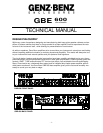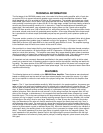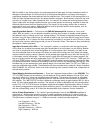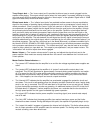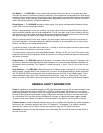
- 3 -
With the switch in the active position, the preamp presents a lower gain and input impedance which is
tailored to active pickups. An active pickup is, for all practical discussions, any pickup that uses pre-
amplification between the pickup element and the amplifier input. The purpose of this pre-amplifier is to
buffer the high impedance signal from the pickup element (magnetic, piezo-ceramic, piezo-film etc) and
convert it to a higher level, lower impedance form. It is common for a bass with active pickups to have
higher output level and longer sustain because only a small portion of the energy required to make the
electrical signal comes from the vibrating string. The majority of the energy comes from an external
power source such as a battery. Additional features may be provided with the active pickup, such as
equalization, volume control and compression.
Input Signal Mute Switch — The input on the GBE-600 bass amplifier includes an “input mute”
switch. With this switch, you can place the amplifier (and the direct output) in standby mode between
sets without having to change any of your volume settings. This feature is especially handy during the
set when using the tuner output since you will still be able to use your tuner without having sound come
from the amplifier or P.A. system. No more re-patching or fumbling in the dark! A red LED turns on when
the input mute is active, reminding you that you are in “stand-by” mode. This feature is also controlled by
the optional 4 button footswitch.
Input Gain Controls & O/L LEDs — The “input gain” controls, in conjunction with the signal and clip
LEDs, allow you to adjust the preamp input gain sensitivities to the instrument you are playing. Basses
can have an output level from a few thousandths of a volt to several volts. Generally, you want to see
only an occasional flash of the red clip LED when you really hit the string hard, then adjust the master
volume control for playing volume. Distortion of the preamp gain stage will occur when the red clip LED
is illuminated, so plan accordingly. The best signal to noise ratio will result with the above method. Set-
ting your playing volume will be a combination of the “FET gain control” (FET channel), “TUBE gain con-
trol” and “TUBE volume control” (TUBE CHANNEL) and the “master volume control”, depending in part
on individual preference. Intentional overloading of the tube channel may be desirable and the O/L LED
indicates that you are operating the tube preamp stage in the overdrive mode. The FET and TUBE pre-
amps are switchable and mixable. These features are also controlled by the optional 2 button footswitch.
Both CHANNEL O/L LEDS are active at all times monitoring each channel’s audio level, independent of
channel switch position.
Signal Shaping Switches and Controls — There are 3 separate shaping filters on the GBE-600. The
“L.F. EXTEND” lowers the low frequency roll-off response of the preamp (between 30 and 45 Hz) to al-
low the full effect of 5+ string and extended scale instruments. The amount of extension is adjustable
depending on the setting of the corresponding control. Use this function with care due to the power of
this amplifier. The “MID SCOOP” function introduces a midrange scoop at approximately 800 Hz, with a
lower “Q” than typical equalization provides. The amount of scoop is adjustable with the corresponding
control. The “H.F. ATTACK” function increases brightness and sparkle (approximately 4KHz) of the sig-
nal, allowing exaggeration of percussive effects and string sound. The amount of attack is adjustable
with the corresponding control. All 3 filters are footswitchable by the optional 4 button footswitch.
Active 5 Band Equalization — The “active 5 band equalization” used in the GBE-600 amplifiers is
composed of 1 shelving low frequency control, 3 peaking midrange controls and 1 shelving high fre-
quency control. These filters are not interactive and are effective as an advanced tone control system.
The filters have a cut/boost range of +/- 12dB and a smooth, musical sounding response.
Low Frequency - 80 Hz
Low-Mid Frequency - 200 Hz
Mid Frequency – 500 Hz
High-Mid Frequency – 1250 Hz
High Frequency - 4000 Hz



